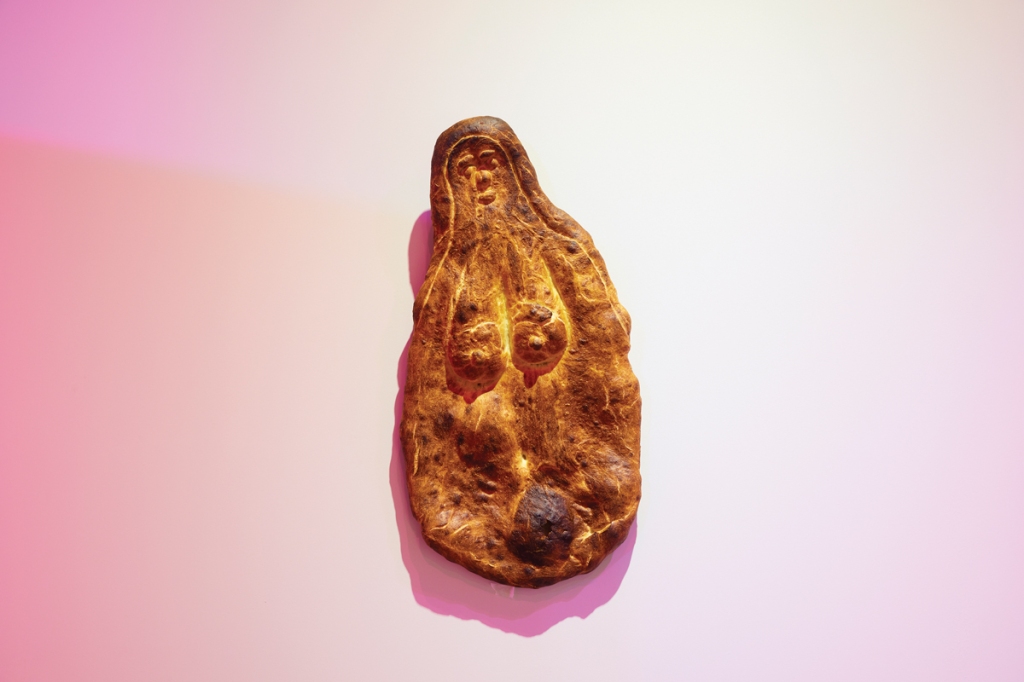 Vaginal Davis’s bread work, Dirty Mariah Lower Mesopotamia 40 BC, at the 2021 Gwangju Biennale. Photo Sang tae Kim
Vaginal Davis’s bread work, Dirty Mariah Lower Mesopotamia 40 BC, at the 2021 Gwangju Biennale. Photo Sang tae Kim
As the world of art broadens its borders and sets its sights on all realms of culture, ARTnews surveyed collaborations of various kinds for the August/September issue of the magazine. Stay tuned as roundups related to different categories—Art x Fashion, Art x Music, Art x Science, Art x Food, and Artists x Artists—join related feature stories online in the weeks to come.
Vaginal Davis x Bread
At this year’s Gwangju Biennale in South Korea, a large loaf of bread hung on the wall of a room bathed in pink light. From a distance, it resembled a bulbous lute or a thick bodyboard; up close, it revealed itself as a baked good whose undulating crust suggested the presence of eyes, a nose, a mouth, and two breasts.
This was the work of Vaginal Davis, who over the course of a four-decade career has put out punk records, made movies, performed as a drag queen, run a storied apartment gallery, drawn with makeup and food coloring—and also made the occasional bread sculpture with the help of various bakeries.
“My late mother, Mary Magdalene Duplantier, wasn’t an artist but made art objects from bread and food substances, so in homage to her, I first created the bread sculptures,” Davis said from her home base in Berlin. For her part, Davis has taken a different approach to the medium. “My mother made her bread sculptures rather small, whereas mine are life-size and more totemic.”
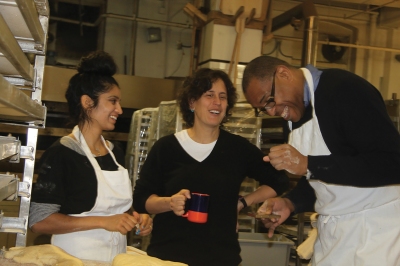 Vaginal Davis (right) at Grandaisy Bakery with owner, Monica Von Thun Calderón (center) and artist Baseera Khan (left) Courtesy Grandaisy Bakery
Vaginal Davis (right) at Grandaisy Bakery with owner, Monica Von Thun Calderón (center) and artist Baseera Khan (left) Courtesy Grandaisy Bakery
Davis showed her first baked goods in a 2012 show at the New York gallery Participant Inc., which included Dirty Mariah—named after a line in a song by the British band Shampoo referring to pop star Mariah Carey and in the form of a sprawl of white bread that “came out looking like the Venus of Willendorf,” Davis said. In the same show, a 6-and-a-half-foot-tall piece of bread modeled after Justin Timberlake sported a gargantuan phallus.
The vaunted Grandaisy Bakery in downtown New York handled that unusual baking job in a collaboration that came about through artist Jonathan Berger, a friend of both Davis and the bakery’s owner, Monica Von Thun Calderón. After emerging from huge ovens and cooling, the nude bread bodies received a coating of transparent Paverpol to preserve them.
The Gwangju piece, Dirty Mariah Lower Mesopotamia 40 BC, was smaller, since the ovens available in South Korea were more compact than the ones she used in New York. Unable to travel because of the pandemic, Davis sent drawings to the Gwangsu bakery in Gwangju, which got the job done. A potent presence of womanhood and self-created identity, the loaf was a ghostly and tender spirit as it presided over the exhibition’s run. It cracked a bit over time, but it held its form. It looked weirder, and better, with age.
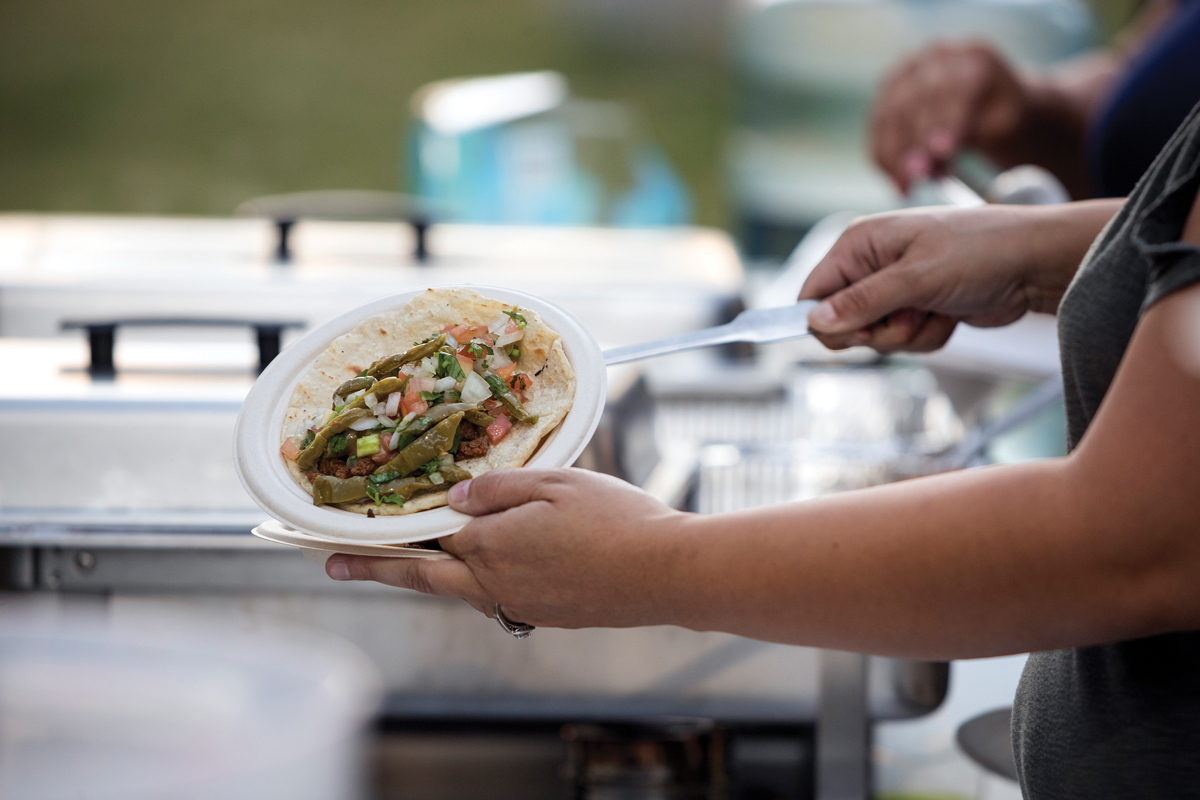 Eva Aguila’s project Comida a Mano at the Reseda Recreation Center, part of the 2019 “Current:LA” biennial. Panic Studio LA, Courtesy City of Los Angeles Department of Cultural Affairs (DCA) Eva Aguila x Tortillas
Eva Aguila’s project Comida a Mano at the Reseda Recreation Center, part of the 2019 “Current:LA” biennial. Panic Studio LA, Courtesy City of Los Angeles Department of Cultural Affairs (DCA) Eva Aguila x Tortillas
While fans of food-related art usually need luck to come across an exhibition with even a single bite of art-related food, the 2019 “Current:LA” biennial took food as its central theme, with quite a few edibles on offer. Artist Eva Aguila, cofounder of the Coaxial Arts Foundation in Los Angeles, created a project that—true to its name, Comida a Mano—was an ode to eating with one’s hands. At its core was a sturdy two-ton earthenware oven that Aguila commissioned, after extensive research, from artist and designer Bob Dornberger, with a flat top upon which a comal griddle could be placed to make tortillas.
 Chef Maria Ornelas at work. Panic Studio LA, Courtesy City of Los Angeles Department of Cultural Affairs (DCA)
Chef Maria Ornelas at work. Panic Studio LA, Courtesy City of Los Angeles Department of Cultural Affairs (DCA)
As part of the project one evening in a park in Reseda, Maria Ornelas, owner of the local Izzy’s Café, made fresh tortillas from masa for all comers. “It’s a lot of muscle memory and can only be accomplished with several years of experience,” Aguila said of the process. Laid out as fillings for the fresh tortillas was a bounty of guacamole, nopales, beans, rice, and more. Accompanying the feast was a screening (curated by Aguila with artist Arshia Fatima Haq) of videos made by women of color on the topic of utensil-free eating.
“I wanted to have a commonality with other cultures from all over the world and stop the stigma of feeling uncivilized for eating without utensils,” Aguila said. She shot her own film for the event; it includes interviews with a cousin who is a tortilla maker in La Paz, Mexico, as well as with her father, who discusses his love for eating with tortillas. He explains that “with a spoon, the food doesn’t taste as good.”
Thinking back on the project, Aguila, who’s now based in New York, recalled cooking her usual breakfast of eggs and tortillas in a comal while she was living in Portland, and her roommate remarking one day, “Whoa, you really are Mexican.” “I was taken aback and became very conscious of the act of eating tortillas,” she said. “My otherness of being first-generation Mexican-American became very apparent in a primarily white city.”
Her oven project, in response, provided a means for connecting with her family and her heritage. “I sometimes feel like I’m between two cultures, and food is the one way I can remember where I am from,” Aguila said. Her goal is to have the oven placed permanently in a public space where it can be used by a community. For now, though, it resides in the backyard of her aunt’s house in San Bernardino, California—where it gets plenty of use.
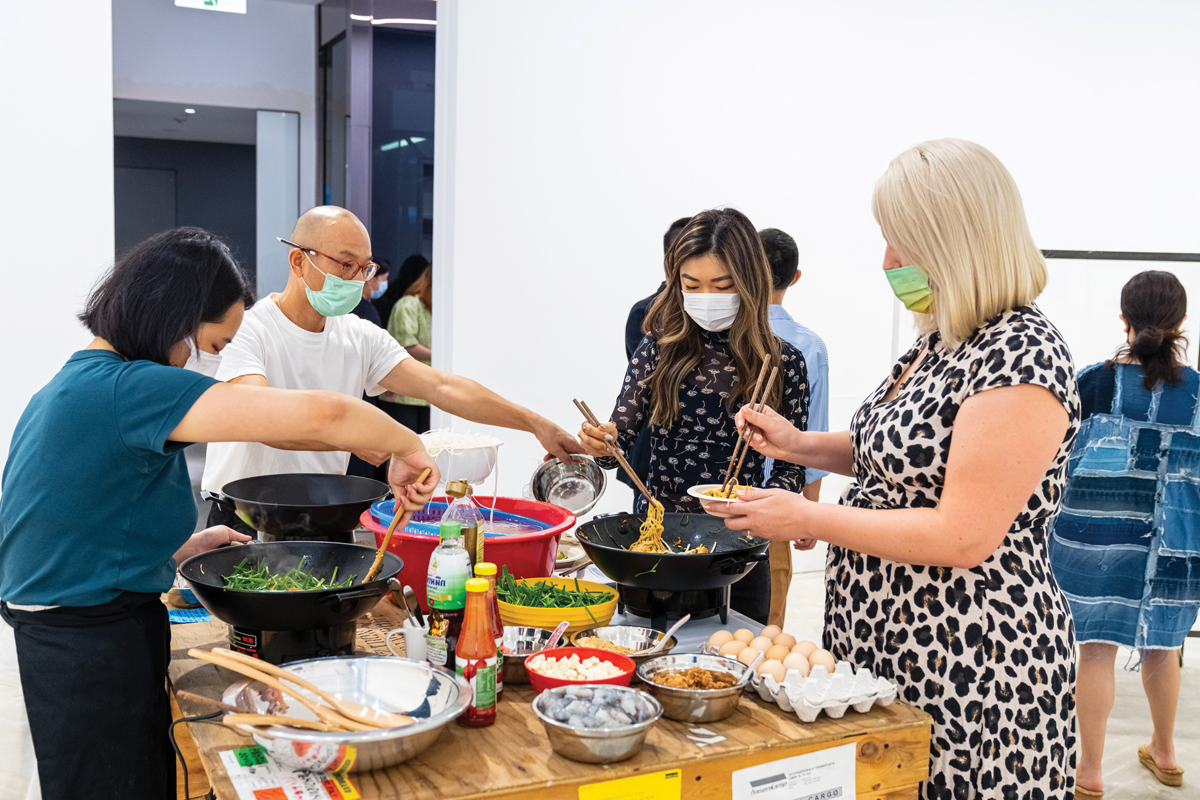 Rirkrit Tiravanija’s untitled (pad thai), from 1990, was recreated at David Zwirner gallery in Hong Kong this past May. Courtesy David Zwirner, Hong Kong Rirkrit Tiravanija x Pad Thai
Rirkrit Tiravanija’s untitled (pad thai), from 1990, was recreated at David Zwirner gallery in Hong Kong this past May. Courtesy David Zwirner, Hong Kong Rirkrit Tiravanija x Pad Thai
This past May, Rirkrit Tiravanija, the godhead of so much food-related art (and art inversely related), was about to tell ARTnews about some of his upcoming endeavors—but, as it happened, he had just completed a quite significant one. “I’m going to do a little plug: We started up Unclebrother,” he said of the beloved summertime restaurant and gallery he began in 2015 in upstate Hancock, New York, with dealer Gavin Brown. Closed last summer because of the pandemic, Unclebrother is back in operation at the former car dealership it calls home.
At the time, Tiravanija was also getting ready to stage a project with his frequent collaborator, Finnish chef Antto Melasniemi, for the Helsinki Biennial, which opened in June and runs through September. They’ve cooked together all over the world, and their latest effort involves growing mushrooms at the Helsinki Art Museum. Tiravanija explained that their plan was to use the mushrooms for cooking on-site, and to present talks on topics like sustainable food.
Melasniemi, who runs a number of restaurants of his own in Helsinki, met Tiravanija about a decade ago at a talk at Stockholm’s Moderna Museet by Ferran Adrià, the spectacularly inventive chef whose elBulli restaurant in Spain was a sort of (very exclusive) satellite of Documenta 12 in Kassel, Germany, in 2007. As elBulli was closing in 2011, Tiravanija made the pilgrimage and took part in a memorable affair. “Remembering certain surprising dishes and details, he said, “It was like an art experience.”
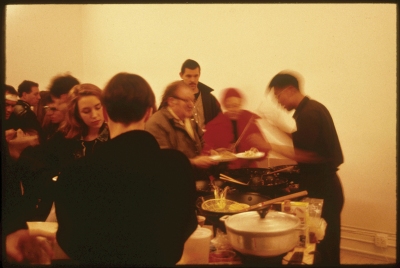 Rirkrit Tiravanija’s untitled (pad thai), from 1990, at Paula Allen Gallery in New York. Courtesy David Zwirner, Hong Kong
Rirkrit Tiravanija’s untitled (pad thai), from 1990, at Paula Allen Gallery in New York. Courtesy David Zwirner, Hong Kong
Since 1990, Tiravanija has served food—usually Thai cuisine—in art spaces as artworks, and the presentation is typically straightforward: wait in line, grab a bowl, and enjoy. This past May, he restaged his first such food work, untitled (pad thai), in a group show at David Zwirner gallery in Hong Kong (where he’ll also present a solo show next year). While the artist sometimes gets involved in the cooking, it is ultimately up to whoever owns the work or is otherwise presenting it to deal with kitchen duties. In Hong Kong, a former assistant, Tony Huang Zhiyong, who now works for Zwirner, got the job.
“You know how to do it, so just do it,” Tiravanija told the cook. He also pointed him to a book with instructions. “I took the recipe from an American lady who made a Thai cookbook, so she was interpreting Thai food as an American,” Tiravanija said of tweaks to traditional ingredients that included trading tamarind for ketchup. “It’s bastardized totally, but in a way it works,” he said. “The idea of using ketchup was totally brilliant.”
Tiravanija’s food pieces invite big questions about art. Is the art in the cooking or the idea? If the artist is not present, are we experiencing what he intended? His approach is to let things go, à la John Cage’s devotion to chance operations, he said. (Cage, for his part, also had an interest in food and, famously, an obsession with mushrooms.)
Tiravanija proposed that one could think of his recipes as musical compositions or Fluxus-like scores. “Whoever picks it up is going to make it to their taste or their skill level. It’s difficult for people to understand that I have given them the authority,” he said. “I’ve invested in them the power to do what they can and will.”
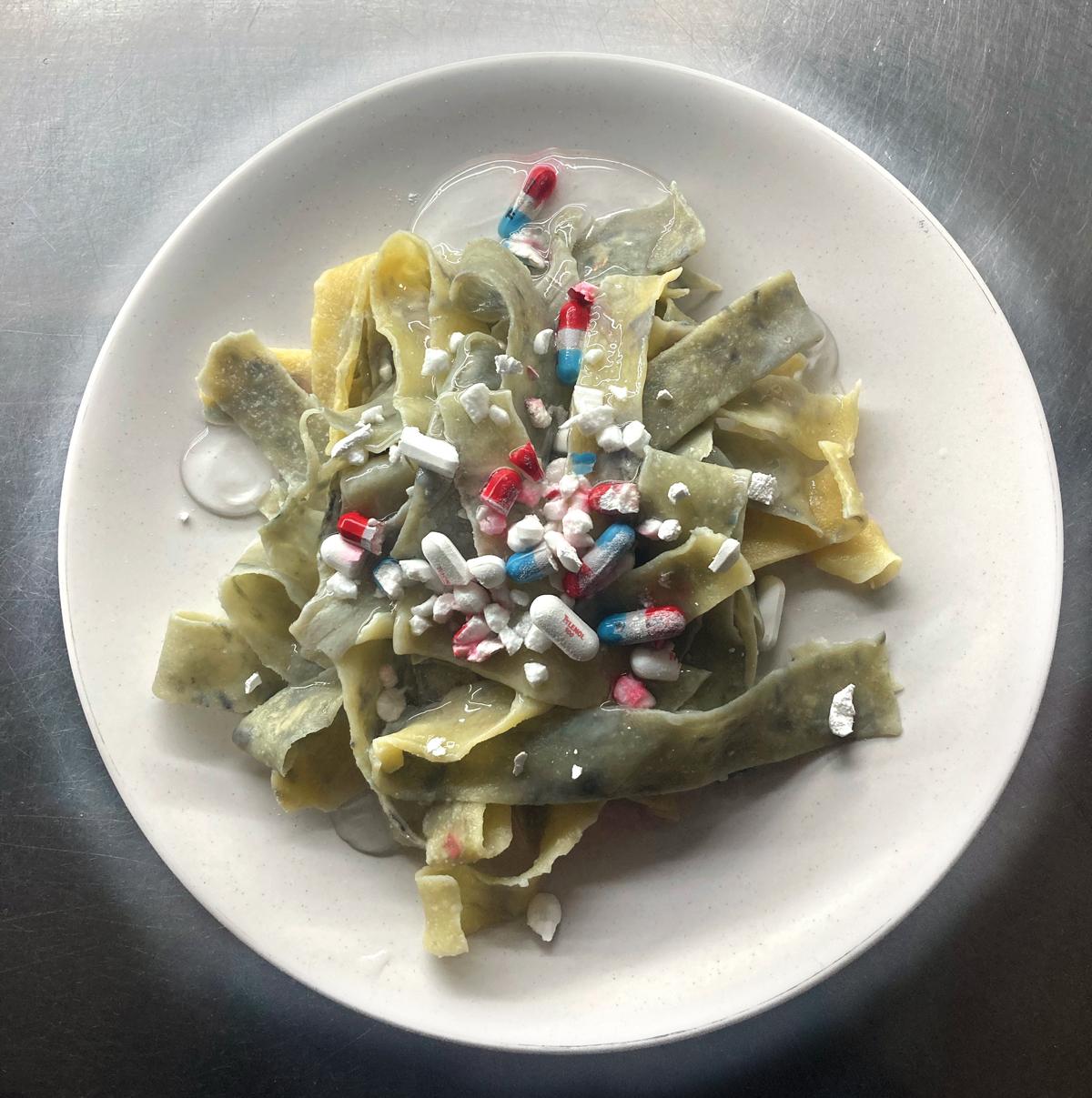 Josh Kline’s USA Today al Dente, from 2021. Photo Allyson Vieira/Courtesy 47 Canal and Always Fresh, New York Josh Kline x Pasta
Josh Kline’s USA Today al Dente, from 2021. Photo Allyson Vieira/Courtesy 47 Canal and Always Fresh, New York Josh Kline x Pasta
In 2014 Josh Kline placed a refrigerator on the High Line in Manhattan and filled it with sleek bottles of brightly colored juice. They looked delectable—until you read the ingredients on their labels. A richly textured green beverage included baby spinach, baby kale, tennis ball, and Nyquil. A purple number featured coconut water, turmeric, yoga mat, and glass. To prevent accidental imbibing, the doors on the work, titled Skittles, were locked shut.
“Taste, and the role it plays in capitalism, has been a theme in my work from the beginning,” Kline said of his interest in substances that “we use to alter our bodies.” His distinctive brews of edible and otherwise questionable and even poisonous materials can be both unsettling and poignant. Energy Drip, one of Kline’s works from 2013, is an IV bag with a dark-tangerine liquid made of Red Bull, Provigil (a pill that treats narcolepsy), and gasoline—a menacing monument to overworked truck drivers or coders, or their fuel.
In a less liquid pursuit, Kline tried his hand at noodles a few years ago, assembling a dish with squid ink and pages of the New York Times. And so, when artist Allyson Vieira and writer Brian Droitcour (from the ARTnews sister publication, Art in America) approached him about participating in a group exhibition this past spring at Always Fresh, a space in a former pizzeria on Manhattan’s Lower East Side, Kline thought about making some pasta—“this time using USA Today with hand sanitizer and crushed Tylenol,” he said.
The artist’s studio assistants—“all serious about food and quite skilled in the kitchen,” Kline said—created the dried pasta and crushed the pills. It was an ephemeral piece, with pappardelle being cooked up each morning of the exhibition’s monthlong run and then discarded at the end of the day. The result engendered simultaneous sensations of pleasure and disgust, sending the mind into a tailspin. “It’s a pasta about 2021,” Kline said.
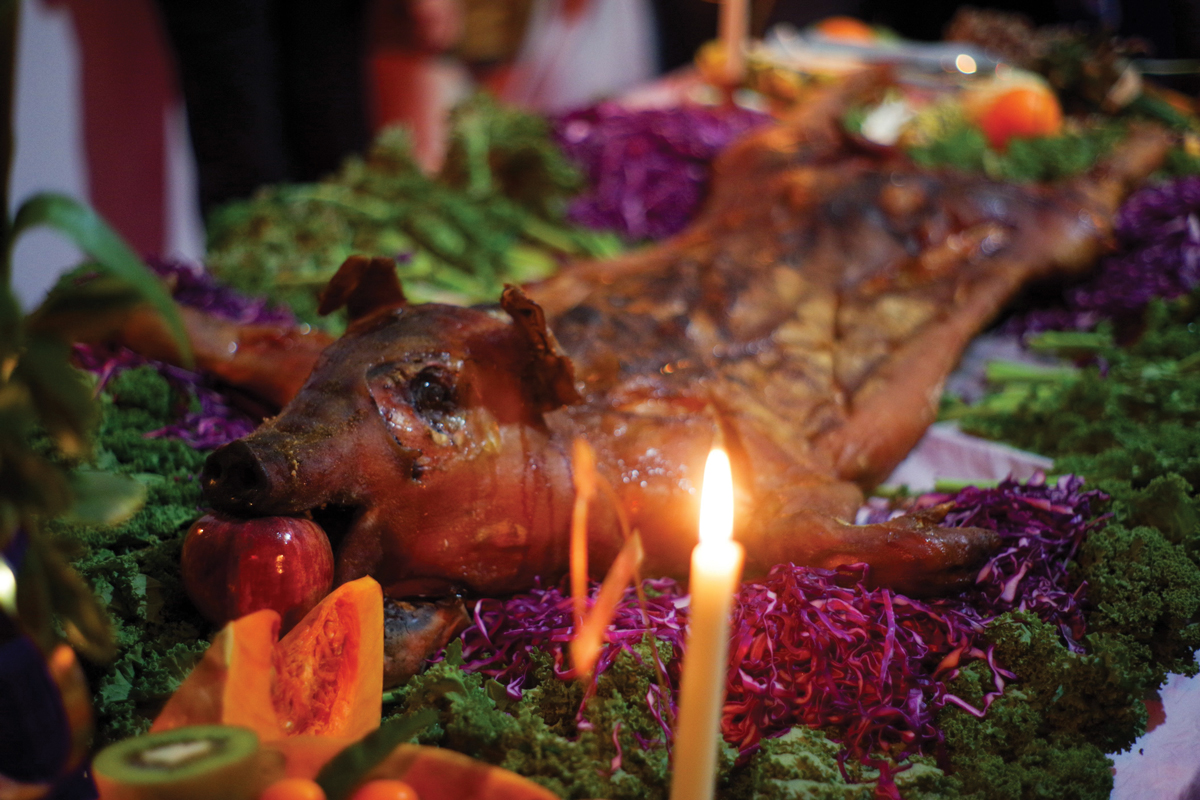 Roast pig and vegetables by candlelight fromG. William Webb’s leaPInG in 2020. Photo Robin Cameron G. William Webb x Roasted Pig
Roast pig and vegetables by candlelight fromG. William Webb’s leaPInG in 2020. Photo Robin Cameron G. William Webb x Roasted Pig
In late February 2020, scores of art types crammed into La Kaje, a project space near a Brooklyn highway, for a night of dining and art. The centerpiece was a 4-foot-long roasted pig splayed out atop a spread of vegetables that could be used to garnish tacos.
“We hung the pig outside overnight, on a secure rooftop, and had the advantage of the colder February evening to preserve the meat while it drained upside-down,” said artist G. William Webb, who organized the event, which also featured a screening of Walt Disney’s The Three Little Pigs and captivating performances by Guy Henry and Miles Huston, among other delights. Food stylist Scotty Fletcher handled the roasting.
It was an evening staged by Webb’s family and friends, with one intriguing idea leading to the next at the space run by fellow artists Jacques Louis Vidal and Kate Levant. Webb’s wife, artist Robin Cameron, contributed welded-brass candleholders to illuminate the scene. His sister-in-law, graphic designer Tracy Ma, made a tablecloth colored with raspberries and beets. Other food stylists of Webb’s acquaintance prepared the vegetables and served up chipotle-dyed corn tortillas.
Webb was aiming for “maximal theatrical flair,” he said. “We did the roast on Leap Day [February 29] to celebrate the elusive nature of time. The title, leaPInG, played on a fantastical association with flying pigs. The vanitas still life, like memento mori, set the tone for the atmosphere.”
Everyone seemed to have a good time. “Food is a great way to bring people together and break down some of the social pressures that might be associated with an art opening,” Webb said. But there was a certain bittersweetness to the festivities—both in the moment and in hindsight. The gathering was about “celebrating life through material impermanence,” Webb said. And no one could have known that the next day, New York State would confirm its first positive test for the coronavirus—and that 20 days later, the order would come to shut down.
A version of this article appears in the August/September 2021 issue of ARTnews, under the title “Art X Food.”
Source link : https://www.artnews.com/art-news/artists/art-food-collaborations-vaginal-davis-rirkrit-tiravanija-1234603683












